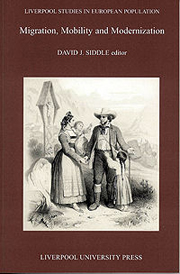Book contents
- Frontmatter
- Contents
- List of Figures
- List of Tables
- 1 Introduction
- 2 Nephews, Dowries, Sons and Mothers: the Geography of Farm and Marital Transactions in Eastern Ireland, c. 1820–c.1970
- 3 Mobility, Kinship and Commerce in the Alps, 1500–1800
- 4 People from the Pits: the Origins of Colliers in Eighteenth-Century South-West Lancashire
- 5 Motives to Move: Reconstructing Individual Migration Histories in early Eighteenth-Century Liverpool
- 6 Urban Population and Female Labour: the Fortunes of Women Workers in Rheims before the Industrial Revolution
- 7 Mobility Among Women in Nineteenth-Century Dublin
- 8 Tramping Artisans in Nineteenth-Century Vienna
- 9 Migration and Urbanization in North-West England: a Reassessment of the Role of Towns in the Migration Process
- Index
5 - Motives to Move: Reconstructing Individual Migration Histories in early Eighteenth-Century Liverpool
- Frontmatter
- Contents
- List of Figures
- List of Tables
- 1 Introduction
- 2 Nephews, Dowries, Sons and Mothers: the Geography of Farm and Marital Transactions in Eastern Ireland, c. 1820–c.1970
- 3 Mobility, Kinship and Commerce in the Alps, 1500–1800
- 4 People from the Pits: the Origins of Colliers in Eighteenth-Century South-West Lancashire
- 5 Motives to Move: Reconstructing Individual Migration Histories in early Eighteenth-Century Liverpool
- 6 Urban Population and Female Labour: the Fortunes of Women Workers in Rheims before the Industrial Revolution
- 7 Mobility Among Women in Nineteenth-Century Dublin
- 8 Tramping Artisans in Nineteenth-Century Vienna
- 9 Migration and Urbanization in North-West England: a Reassessment of the Role of Towns in the Migration Process
- Index
Summary
Evidence from a variety of sources suggests that in the pre-industrial period, the population of England was highly mobile, often over short distances. Much of this movement was in-migration to towns and was fundamental in engineering sustained population growth and the supply of labour necessary to maintain the manufacturing, trading, and service sectors of the early urbanizing economies.
This chapter seeks to give a flavour of the potential for multiple source analysis when exploring migration issues. It draws upon the findings of a recent research project seeking to explore ‘The Liverpool Community and Urban Growth, 1660–1750’. That investigation employed multiple record linkage to construct detailed biographies of individual townsfolk and to reconstruct their associations within the widest social and occupational base. Set against the findings of aggregate studies of Liverpool to date, four detailed case histories will be presented to demonstrate migration and mobility characteristics at the experience level of the individual, and of the individual's interaction and connectivity with others.
LIVERPOOL
At the Restoration, it has been estimated that Liverpool had little more than 1,500 inhabitants. By the end of the seventeenth century, the population total had risen to approximately 5,000–5,500 and was to almost double in the first 20 years of the eighteenth century, and double again to reach 20–22,000 by the late 1750s.
Analysis of parish register totals of baptisms and burials reveals that natural increase throughout the period was often slight, and between the mid-1720s and mid-1740s almost negligible.
- Type
- Chapter
- Information
- Migration, Mobility and Modernization , pp. 90 - 118Publisher: Liverpool University PressPrint publication year: 2000



